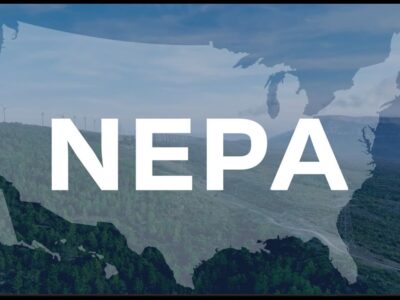Data Center Permitting: A Roadmap
AI is fueling a surge in data center construction. Here’s what you need to know.
The Department of Energy estimates that power use by data centers could be three times as high in 2030 as it was in 2023. The reason is AI, which is fueling a big buildout of new data and computing centers. These facilities will require permits, as a new White House report on AI acknowledges. This wave of new facilities is going to be a jolt to the permitting system, depending on the source of the power. Here’s what you need to know about that.
Below, you’ll find a roadmap to the permitting process. The AI Report proposes some shortcuts, and I’ll offer some initial thought about them as well. I’ll break the issues down into several category since they involve different processes.
Two points before I begin: First, I’m not going to discuss whether developing AI is a good thing (maybe even a crucial thing) or a bad thing (maybe even catastrophic). You undoubtedly have your own opinion about that. Second, I’m limiting the discussion to environmental issues. Thus, I’ll be skipping the issues relating to electricity rates and reliability, which are important but not directly environmental.
1. Projects with a Federal Nexus.
A federal nexus could involve federal funding or the used of federal land for the data center itself or for an associated generation source. It might also involve the need for a permit to fill wetlands. In addition to the air and water permitting discussed below, the federal nexus would trigger the normal federal permitting process. This could require and environmental impact statement or at least the more streamlined version, an environmental assessment. Depending on location, there might also need to be consultation with the Fish & Wildlife Service to ensure Endangered Species Act compliance.
The AI Report suggests creating categorical exclusions that would exempt at least parts of an AI project from these requirements. To establish a valid categorical exclusion, an agency would need to show normally a project of this type would not involve significant environmental impacts. Color me skeptical, at least at this point. These are really big facilities with big environmental footprints. Moreover, even if the agency did have a categorical exclusion, it would have to go ahead with the environmental review process whenever special circumstances indicate that impacts would be significant, which would probably be litigated.
The Report also calls for using a streamlined procedure, the FAST-41 process, for permitting. I believe this is likely to be found legally valid.
2. Dedicated Generation Generation Sources
Some projects would have their own power sources rather than relying on the grid. The fewest issues would arise with use of renewables. A nuclear plant would require permitting from the Nuclear Regulatory Commission and would also require a Clean Water Act permit for taking cooling water from a stream or lake, and separate permitting for discharging used cooling water due to impurities in the used water. A fossil fuel plant would also need those permits and would also require a permit under the Clean Air Act if its emissions exceeded a certain threshold (100 tons per year in non-attainment areas).
The AI Report suggests use of a nationwide water pollution permit for data centers, but it’s not clear how this could be done for new powerplants unless there’s some plan to put all power plants under nationwide permits. That would be a big step.
2. Data Center Water Pollution
Even if they get their power from the grid, data centers use a lot of water for cooling, because the chips generate a lot of heat and have to be kept in a narrow temperature raise. The data is sketchy about the magnitude of this water use. Half of data centers don’t even track their own water use. But indications are that the scale can be quite large. In 2021, for instance, Google data centers near one Oregon city used over 355 million gallons. The water goes through multiple cycles and concentrates certain pollutants such as dissolved solids and chloride. This may require pretreatment before introduction into a municipal sewage system or a discharge permit with treatment requirements if the water is returned to a stream or lake.
3. Data Center Water Use
Cooling water has to come from somewhere, and a lot may be lost through evaporation (depending on the cooling system). Even Marjorie Taylor Greene says she’s worried about this. It could certainly be a problem in water stressed areas. Water use is generally under state rather than federal law, but the data center might well require a permit.
4. Data Center Air Pollution
Wherever a data center gets its power, it is going to need backup power to deal with outages. In areas where air quality does not meet federal standards (non-attainment areas), the threshold for new source review is 100 tons per year, and it may be necessary to purchase Pollution Reduction Credits. Saying below the cap may require limiting generator runtime. Air pollution monitoring will be needed to ensure compliance with a variety of air quality standards.
Air pollution became a big issue for Elon Musk’s AI center in Memphis. Musk’s firm installed 35 portable gas turbines to help power its supercomputer in a black neighborhood with a high existing pollution burden. There’s a dispute about how many generators have been in use. After a controversy broke out, the local authority issued a permit to run 15 generators until 2027, with total pollution not to exceed the 100 ton per year threshold.
EPA is proposing changes to speed up air permits foer data centers. It wants to delay preconstruction review until actual groundbreaking. It also plans to reduce opportunities for public participation. EPA’s view is that the proess should provide ““the minimum requirements for public participation when it comes to minor emitters so the protest of a few does not unnecessarily thwart progress for all Americans.”
———
Many of these issues would go away with the use of renewable energy and battery storage. But, in part due to Trump’s energy policies, much of the power is likely to come from fossil fuel plants. The Trump Administration is clearly going to do its best to free the industry from environmental limits. We’ll see how successful that is going to be.







“The Trump Administration is clearly going to do its best to free the industry from environmental limits.”
So are newsome and Weiner freeing the industry from environmental limits as they have just done in their attack on CEQA. Data centers such as your article features are apparently one of the developments that are exempt from CEQA in the new legislation that newsome and Weiner have championed.
This is a huge giveaway that Newsom and Weiner are courting the tech industry with.